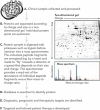Proteomics and disease: opportunities and challenges
- PMID: 15938685
- PMCID: PMC7168462
- DOI: 10.5694/j.1326-5377.2005.tb06817.x
Proteomics and disease: opportunities and challenges
Abstract
Since the human genome was sequenced, there has been intense activity to understand the function of the 30,000 identified genes; attention has now turned to the products of genes--proteins. Proteomics is the large-scale study of the structure and function of proteins; it includes the rapidly evolving field of disease proteomics, which aims to identify proteins involved in human disease and to understand how their expression, structure and function cause illness. Proteomics has identified proteins that offer promise as diagnostic or prognostic markers, or as therapeutic targets in a range of illnesses, including cancer, immune rejection after transplantation, and infectious diseases such as tuberculosis and malaria; it has the potential to allow patient-tailored therapy. Some major challenges remain, both technical (eg, detecting "low-abundance" proteins, and maintaining sample stability) and in data management (eg, correlating changes in proteins with disease processes).
Similar articles
-
Proteomics: clinical applications.Clin Lab Sci. 2007 Fall;20(4):245-8. Clin Lab Sci. 2007. PMID: 18069451 Review.
-
The ongoing evolution of proteomics in malignancy.Drug Discov Today. 2007 Sep;12(17-18):700-8. doi: 10.1016/j.drudis.2007.07.015. Epub 2007 Aug 24. Drug Discov Today. 2007. PMID: 17826682 Review.
-
Cancer proteomics: Serum diagnostics for tumor marker discovery.Ann N Y Acad Sci. 2004 Jun;1022:286-94. doi: 10.1196/annals.1318.044. Ann N Y Acad Sci. 2004. PMID: 15251974 Review.
-
Proteomics with two-dimensional gel electrophoresis and mass spectrometry analysis in cardiovascular research.Methods Mol Med. 2006;129:15-26. doi: 10.1385/1-59745-213-0:15. Methods Mol Med. 2006. PMID: 17085802
-
[Progress in proteomics].Sheng Wu Gong Cheng Xue Bao. 2001 Sep;17(5):491-3. Sheng Wu Gong Cheng Xue Bao. 2001. PMID: 11797206 Review. Chinese.
Cited by
-
Potential applications of global protein expression analysis (proteomics) in morbid obesity and bariatric surgery.Obes Surg. 2008 Jul;18(7):905-10. doi: 10.1007/s11695-007-9337-2. Epub 2008 Mar 11. Obes Surg. 2008. PMID: 18330661 Review.
-
Emerging Approaches to Understanding Microvascular Endothelial Heterogeneity: A Roadmap for Developing Anti-Inflammatory Therapeutics.Int J Mol Sci. 2021 Jul 21;22(15):7770. doi: 10.3390/ijms22157770. Int J Mol Sci. 2021. PMID: 34360536 Free PMC article. Review.
-
Subcellular proteomics.Nat Rev Methods Primers. 2021;1:32. doi: 10.1038/s43586-021-00029-y. Epub 2021 Apr 29. Nat Rev Methods Primers. 2021. PMID: 34549195 Free PMC article.
-
Recent progress in tuberculosis diagnosis: insights into blood-based biomarkers and emerging technologies.Front Cell Infect Microbiol. 2025 May 8;15:1567592. doi: 10.3389/fcimb.2025.1567592. eCollection 2025. Front Cell Infect Microbiol. 2025. PMID: 40406513 Free PMC article. Review.
-
Uncovering the Depths of the Human Proteome: Antibody-based Technologies for Ultrasensitive Multiplexed Protein Detection and Quantification.Mol Cell Proteomics. 2021;20:100155. doi: 10.1016/j.mcpro.2021.100155. Epub 2021 Sep 28. Mol Cell Proteomics. 2021. PMID: 34597790 Free PMC article. Review.
References
-
- Fontanarosa PB, DeAngelis CD. Medical applications of biotechnology. JAMA 2005; 293: 866–867. - PubMed
-
- Petricoin E, Wulfkuhle J, Espina V, Liotta LA. Clinical proteomics: revolutionizing disease detection and patient tailoring therapy. J Proteome Res 2004; 3: 209–217. 15113096. - PubMed
-
- Ozols RF. Update on the management of ovarian cancer. Cancer J 2002; 8 Suppl 1: S22–S30. - PubMed
-
- Petricoin EF, Ardekani AM, Hitt BA, et al. Use of proteomic patterns in serum to identify ovarian cancer. Lancet 2002; 359: 572–577. 11867112. - PubMed
-
- Baggerly KA, Morris JS, Edmonson SR, Coombes KR. Signal in noise: evaluating reported reproducibility of serum proteomic tests for ovarian cancer. J Natl Cancer Inst 2005; 97: 307–309. 15713966. - PubMed


